| Srl | Item |
| 1 |
ID:
164758
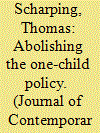

|
|
|
|
|
| Summary/Abstract |
Based on a documentary, statistical and discourse analysis, plus 30 years of interviewing in China, this article investigates the demo-political background of China’s return to a two-child policy in 2015. It pinpoints the contested core issues that fueled a bitter polemic on the future course of Chinese birth policy and continue to fester in ongoing controversies. The article briefly reviews earlier challenges to China’s controversial one-child policy since its inception in 1979/80, details the conflicts and mechanisms shaping the birth planning regime since 2000, and examines the role played by academic counseling, bureaucratic infighting, lobbying and civil society in the about-turn. Comparing birth planning to other policy arenas, it concludes with a discussion of societal and think-tank impact on Chinese political decision-making.
|
|
|
|
|
|
|
|
|
|
|
|
|
|
|
|
| 2 |
ID:
129521
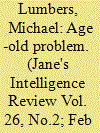

|
|
|
| 3 |
ID:
053970
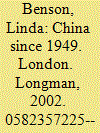

|
|
|
|
|
| Publication |
London, Longman, 2002.
|
| Description |
xviii, 152p.pbk
|
| Series |
Seminar Studies in History
|
| Standard Number |
0582357225
|
|
|
|
|
|
|
|
|
|
|
|
Copies: C:1/I:0,R:0,Q:0
Circulation
| Accession# | Call# | Current Location | Status | Policy | Location |
| 046293 | 951.05/BEN 046293 | Main | On Shelf | General | |
|
|
|
|
| 4 |
ID:
129887
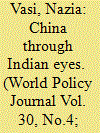

|
|
|
| 5 |
ID:
118203
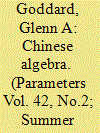

|
|
|
| 6 |
ID:
146224


|
|
|
|
|
| Publication |
Cambridge, Polity Press, 2014.
|
| Description |
xi, 207p.: mappbk
|
| Series |
China Today Series
|
| Standard Number |
9780745669717
|
|
|
|
|
|
|
|
|
|
|
|
Copies: C:1/I:0,R:0,Q:0
Circulation
| Accession# | Call# | Current Location | Status | Policy | Location |
| 058744 | 339.470951/LIA 058744 | Main | On Shelf | General | |
|
|
|
|
| 7 |
ID:
128517
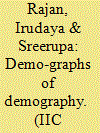

|
|
|
| 8 |
ID:
164760
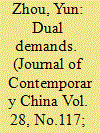

|
|
|
|
|
| Summary/Abstract |
This article investigates fertility intentions and obstacles among young Chinese men and women after the lift of the one-child policy. Over 100 in-depth interviews reveal that while having one child is viewed as the normative step following marriage, various obstacles remain for second-birth transition. Time and financial concerns are salient among both men and women, whereas labor market disadvantage and the perceived incompatibility between work and motherhood create additional hindrances for women. The gendered childcare leave policy, coupled with discriminatory hiring practice, leads women to view multiple childbirths and successful career as fundamentally incompatible. A universal ‘two-child policy’ without additional institutional measures that address work-life incompatibility for women may not successfully boost fertility level, but would rather exacerbate the existing gender inequity in China’s labor market.
|
|
|
|
|
|
|
|
|
|
|
|
|
|
|
|
| 9 |
ID:
164727
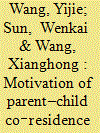

|
|
|
|
|
| Summary/Abstract |
This paper examines the motivations of parent‐child co‐residence behavior in China using data from the China Health and Retirement Longitudinal Study. We test three possible motives: social norms, self‐interest and altruism. We find that social norms play an important role in household co‐residence behavior, showing that the belief that “sons take care of parents” is strong, and children in different birth orders take different responsibilities. Taking the one‐child policy as a natural experiment, we compared co‐residence behavior between only‐child and multi‐child families. This allowed us to test whether children in multi‐child families with wealthier parents more often co‐reside in order to compete for a bequest. We find that parents' wealth is more appealing to children in multi‐child families. The results support the life cycle theory that co‐residence decisions are motivated by self‐interest. We also find some evidence of altruism when parents and children make co‐residence decisions. These findings provide some insights for designing future elder‐support policies in China.
|
|
|
|
|
|
|
|
|
|
|
|
|
|
|
|
| 10 |
ID:
164759
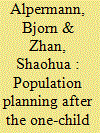

|
|
|
|
|
| Summary/Abstract |
Since late 2013, one of China’s most controversial policies—the one-child policy—has been gradually phased out, culminating in the reorganization of the National Health and Family Planning Commission in early 2018, which saw it drop the family planning part from its name. Has China forgone population intervention and started to pursue a liberal population policy? This article demonstrates that the Chinese political leadership is still determined to steer the direction of future demographic developments, even though it changed course and has to employ new modes of steering. In fact, it has even elevated political steering of demographic developments to new heights under the rubric of ‘top-level design’ (dingceng sheji). This study takes a comparative look at the two ends of the life course, birth and old age, to reveal the continuity and change in population planning and policy discourses in China. In sum, this article finds that while the ‘one-child policy’ is gone for good, population planning in a broader understanding—including policies on birth, aging, migration, and urbanization—is alive and well and it will stay here for the foreseeable future.
|
|
|
|
|
|
|
|
|
|
|
|
|
|
|
|
| 11 |
ID:
128148
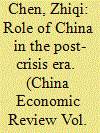

|
|
|